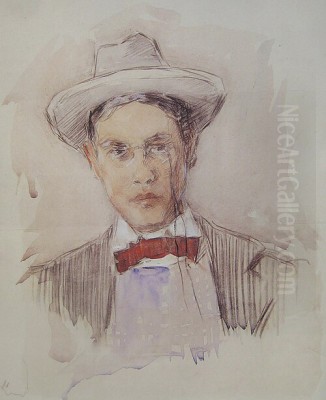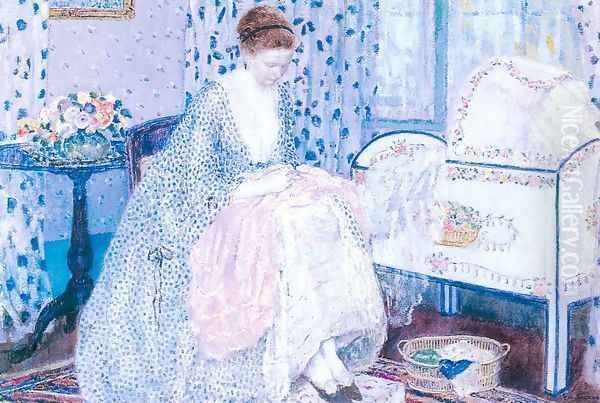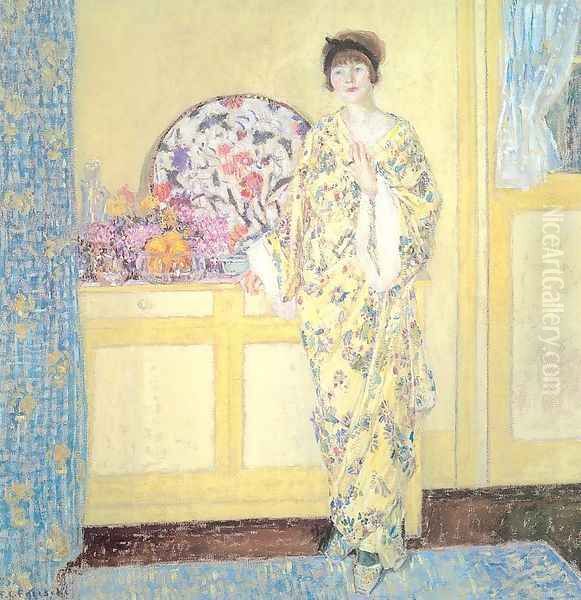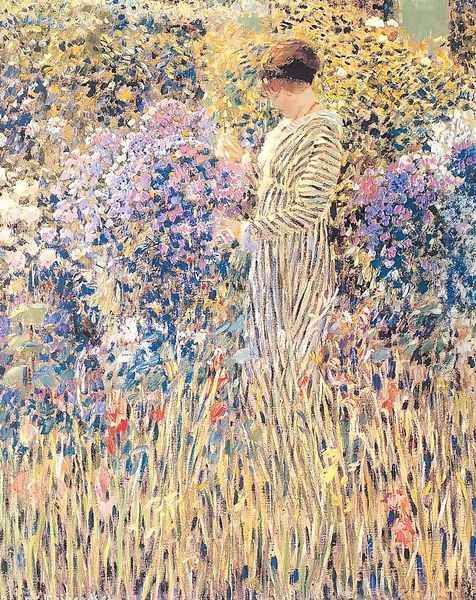
Frederick Carl Frieseke stands as a pivotal figure in the story of American Impressionism. An expatriate artist who spent most of his productive years in France, Frieseke developed a distinctive style celebrated for its vibrant depiction of sunlight, intimate portrayals of women, and decorative sensibility. Born on April 7, 1874, and passing away on August 24, 1939, his life spanned a period of significant artistic transformation, yet he remained largely dedicated to exploring the nuances of light and color within an Impressionist framework. His work, deeply influenced by his time in France, particularly in the art colony of Giverny, continues to enchant viewers with its luminous beauty and serene subject matter.
Early Life and Artistic Awakening
Frederick Carl Frieseke was born in Owosso, Michigan, into a family connected to local industry; his father was the proprietor of a brick manufacturing company. Following the early death of his mother, young Frederick was raised by his father and grandmother. An inclination towards art manifested early in his childhood. A significant catalyst for his burgeoning passion was his visit to the 1893 World's Columbian Exposition in Chicago. The vast display of art and culture undoubtedly left a lasting impression, solidifying his desire to pursue an artistic career. This early exposure set the stage for his formal training and eventual journey abroad.
Formal Training in America
Embarking on his formal artistic education, Frieseke enrolled at the prestigious Art Institute of Chicago in 1894. This institution provided him with a solid foundation in academic drawing and painting techniques. Seeking further development, he moved to New York City to study at the Art Students League. This school was a vibrant hub for aspiring artists, often featuring instruction from prominent figures in American art. While specific instructors during his brief tenure might have included figures associated with the League like Kenyon Cox or others influenced by European trends, the environment itself fostered exposure to diverse artistic ideas circulating in America at the time, including the burgeoning interest in Impressionism championed by artists like William Merritt Chase.
Parisian Studies and Key Influences

In 1898, Frieseke made the pivotal decision to move to Paris, the undisputed center of the art world at the time. This move immersed him in an environment rich with artistic innovation and tradition. He continued his studies at the Académie Julian, a popular choice for foreign students, known for its rigorous training under established academic painters such as Jean-Joseph Benjamin-Constant and Jean-Paul Laurens. He also attended the short-lived Académie Carmen. This school was particularly significant as it was founded and overseen by James McNeill Whistler, another American expatriate artist. Whistler's emphasis on tonal harmony, aestheticism, and refined compositions exerted a considerable influence on Frieseke's developing style, particularly in his subtle color palettes and compositional elegance during his early Parisian years.
Giverny: An Impressionist Haven
The most defining period of Frieseke's career began around 1906 when he settled in Giverny, the small village in Normandy made famous by Claude Monet. Frieseke rented a house previously occupied by fellow artist Theodore Robinson, which notably bordered Monet's own celebrated property and garden. While historical accounts suggest that Frieseke and the aging Monet had limited direct social interaction, the pervasive influence of the Impressionist master's work, particularly his dedication to capturing fleeting effects of light and atmosphere en plein air, was undeniable. Frieseke deeply absorbed the spirit of Giverny, finding endless inspiration in its gardens and the quality of its light.
The Giverny Group and Artistic Exchange
Frieseke became a leading figure among the second wave of American artists who formed a vibrant expatriate community in Giverny. He developed close associations with other painters who shared his enthusiasm for Impressionist aesthetics. This circle included notable artists such as Richard E. Miller, Lawton Parker, Louis Ritman, and Edmund Greacen. This group, sometimes referred to collectively as the Giverny Group or Giverny Impressionists, often explored similar themes – women in sun-dappled gardens, intimate interiors, the play of light on surfaces – though each maintained their individual artistic voice. Their presence solidified Giverny's reputation as a crucial site for the development and dissemination of American Impressionism. Frieseke's work from this period is often seen as exemplary of the group's shared interests.
Artistic Style: Decorative Impressionism
Frieseke's mature style is often characterized as "Decorative Impressionism." This term reflects his unique synthesis of Impressionist techniques with a heightened sense of pattern, design, and harmonious color arrangements. He adopted the Impressionists' interest in capturing the effects of natural light, utilizing broken brushwork and a high-keyed palette to render shimmering sunlight and cool shadows. However, his compositions often possess a greater emphasis on structure and decorative surface qualities than seen in the work of some French Impressionists like Monet. His figures are typically well-drawn and integrated into settings rich with floral patterns, textured fabrics, and ornamental details.
Mastering Light and Color

The defining characteristic of Frieseke's art is his fascination with sunlight. He became a master at depicting dappled light filtering through leaves, casting patterns across figures and landscapes. His canvases often glow with a luminous quality, achieved through the juxtaposition of warm highlights and cool, violet-tinged shadows. His palette frequently favored blues, greens, and lavenders, accented with touches of yellow, pink, and orange, creating an atmosphere that is both vibrant and serene. Unlike the more analytical approach to color theory seen in some Post-Impressionists like Georges Seurat, Frieseke's use of color was primarily intuitive and aimed at capturing the sensory experience of light and warmth.
Subject Matter: The Feminine World
The predominant subject in Frieseke's oeuvre is the female figure, depicted in various settings both indoors and out. He painted women lounging in sunlit gardens, relaxing on balconies, tending to flowers, or engaged in quiet activities within domestic interiors. His models often appear elegantly dressed, sometimes holding parasols – a recurring motif used to filter and diffuse sunlight. These works convey a sense of tranquility, leisure, and idealized femininity. While influenced by the depictions of modern life found in the work of French Impressionists like Pierre-Auguste Renoir and Edgar Degas, Frieseke's portrayal of women tends towards a more decorative and less psychologically probing interpretation, focusing on beauty, grace, and harmony with their surroundings.
The Nude in Sunlight
Frieseke also dedicated a significant portion of his work to painting the female nude, often placing figures in sun-dappled outdoor settings or luminous interiors. These works stand out within American Impressionism for their sensuousness and direct engagement with a subject often considered controversial in the United States at the time. His approach differed from the academic nudes of the Salon; instead, he treated the nude figure as another element within his compositions of light and color, integrating flesh tones with the surrounding environment. While perhaps less overtly voluptuous than some of Renoir's nudes, Frieseke's figures possess a distinct languor and connection to the natural world, bathed in the same shimmering light as his flowers and gardens. These works sometimes faced criticism but are now recognized as an important aspect of his artistic output.
Representative Works

Several paintings exemplify Frieseke's signature style and thematic concerns. The Afternoon at the Beach captures the leisure of elegantly dressed women and children under parasols by the sea, showcasing his skill in rendering bright, reflective light on sand and water. At the Mirror presents an intimate interior scene, likely exploring themes of reflection and femininity, possibly echoing compositions by artists like Degas or Berthe Morisot who frequently depicted women at their toilette. Peace, depicting a mother and child, highlights a more tender, domestic aspect of his work, rendered with his characteristic sensitivity to light and atmosphere. Another notable work, often cited for its market value, is The Garden, which encapsulates his quintessential theme of figures amidst blooming flowers under dappled sunlight.
International Recognition and Acclaim
Frieseke achieved considerable success and recognition during his lifetime, both in the United States and Europe. He exhibited regularly at major venues, including the Paris Salons, the Venice Biennale, and international exhibitions in Munich. His work garnered numerous awards, reflecting the esteem in which he was held. Among his accolades were prestigious gold medals, including one reportedly from an exposition in San Francisco (likely the Panama-Pacific International Exposition of 1915) and another from the Art Institute of Chicago in 1920. A significant honor came in 1920 when the French government named him a Chevalier of the Legion of Honour, acknowledging his contribution to the arts in his adopted country.
Critical Reception and Artistic Reflections
While widely praised for the beauty and technical skill of his work, Frieseke's art occasionally drew criticism. Some contemporary critics found his signature rendering of sunlight, particularly his use of blues and violets in the shadows, to be somewhat formulaic or "artificial" compared to the perceived naturalism of earlier Impressionists. Despite such critiques, his popularity with collectors and museums remained strong. Interestingly, Frieseke himself expressed some ambivalence about his path, reportedly remarking later in life that perhaps a different or more rigorous early art education might have altered his trajectory, though the precise meaning behind this reflection remains open to interpretation.
Later Career and Stylistic Evolution
While Frieseke remained fundamentally committed to his Impressionist-derived style, some observers note subtle shifts in his later work. There is evidence of a move towards more solid forms and a greater emphasis on compositional structure in paintings from the 1920s onwards. This might reflect a broader trend in the art world moving away from pure Impressionism towards the more structured approaches seen in Post-Impressionism, perhaps absorbing distant echoes from the work of artists like Paul Cézanne. However, he never abandoned his core interest in light, color, and the depiction of serene, sunlit scenes. His later works retain his characteristic charm but occasionally possess a more contemplative or monumental quality.
Museum Collections and Market Presence

Today, Frederick Carl Frieseke's paintings are held in the permanent collections of numerous major art museums across the United States and internationally, cementing his place in art history. Prominent institutions showcasing his work include The Metropolitan Museum of Art in New York, the Art Institute of Chicago, the Museum of Fine Arts, Boston, the Telfair Museums in Savannah, the North Carolina Museum of Art, and the Thyssen-Bornemisza Museum in Madrid, Spain. His work was also part of the collection of the Terra Museum of American Art in Chicago before its closure. The continued presence of his art in these significant collections underscores his importance. Furthermore, his paintings command strong prices on the art market, with works like The Garden achieving multi-million dollar results at auction, reflecting sustained collector interest.
Enduring Legacy
Frederick Carl Frieseke's legacy rests on his position as one of the foremost American Impressionists of his generation. As a key member of the Giverny art colony, he played a vital role in transmitting Impressionist ideals back to the United States while developing his own highly personal and recognizable style. His paintings, celebrated for their luminous depictions of sunlight, idyllic scenes of women at leisure, and decorative elegance, continue to resonate with audiences. He masterfully captured moments of beauty and tranquility, creating a body of work that stands as a significant contribution to American art and a testament to the enduring appeal of Impressionism. His ability to synthesize French influences with an American sensibility resulted in paintings that remain cherished for their visual delight and serene atmosphere.